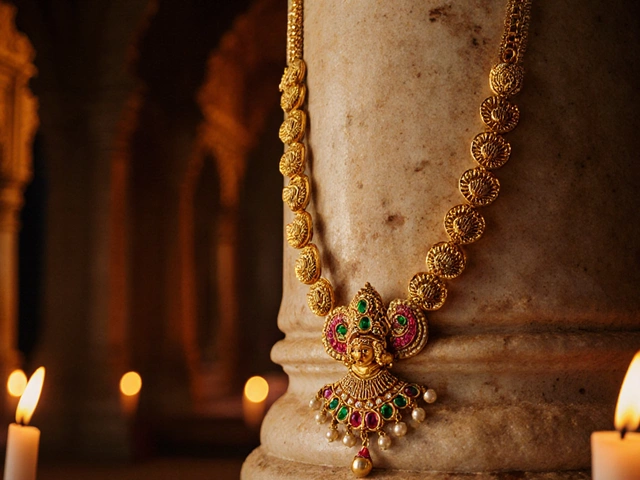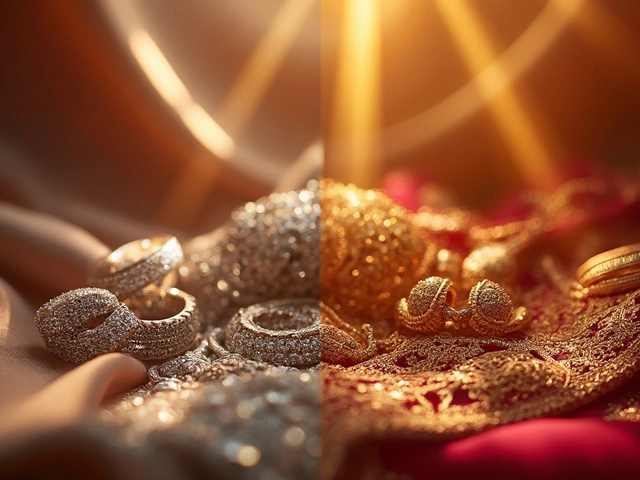Indian Jewelry Rituals Explained – Traditions, Meanings & Modern Tips
Jewelry in India isn’t just about looking good; it’s a living piece of culture. From the bright bangles a bride wears to the simple black bead in a mangalsutra, each item carries a story. If you’ve ever wondered why certain pieces are worn at specific moments, this guide breaks it down in plain language.
Common Jewelry Rituals in Hindu Homes
One of the most recognizable rituals is the use of bangles during festivals and weddings. Red, gold, or black bangles are believed to protect the wearer from negativity and bring luck. Many families keep a set of fresh bangles on hand so that a newborn can be wrapped in them within days of birth – a sign of health and prosperity.
Breaking glass is another ritual many hear about but rarely see. In some Hindu households, a small glass bottle is placed on the altar and smashed during a ceremony to dispel evil spirits. The sound is thought to scare away bad energy, and the shards are later cleaned away as a sign of clearing negativity.
The mangalsutra is a must‑have for married women. Traditionally it features a black bead, which symbolizes longevity and warding off evil. Modern versions might replace the black bead with a small diamond or gemstone, but the core idea stays the same – a promise of protection and commitment.Black bangles have a similar vibe. They’re often worn by newlyweds to signify the binding of two lives. The color black is linked to absorbing negative vibes, so a pair of black bangles is thought to keep the marriage strong.
Modern Twists on Traditional Practices
Today, many people blend old customs with contemporary style. For example, some couples choose a thin gold chain instead of a heavy traditional mangalsutra, making it easier to wear daily while still honoring the ritual. Others add tiny charms that reflect personal interests – a tiny music note for a musician or a mini lotus for a spiritual seeker.
If you’re not comfortable wearing a full set of bangles, try a single black bangle on your wrist. It still carries the protective meaning but looks sleek with modern outfits. Pair it with a simple gold ring for a balanced look that respects tradition without feeling heavy.
When it comes to breaking glass, you can symbolically snap a small piece of decorative glass at the start of a new project or a housewarming. The act is quick, safe, and keeps the intention of clearing negativity alive.
Remember, the power of these rituals isn’t in the metal alone; it’s in the intent you bring. Saying a short prayer, thinking of a positive wish, or simply acknowledging the meaning behind the piece makes the tradition feel alive.
In short, Indian jewelry rituals blend protection, luck, and love. Whether you stick to the classic designs or experiment with modern twists, the key is to wear each piece with respect for its story. By doing so, you turn a beautiful accessory into a meaningful part of your daily life.
Understanding the Kirpan: Rituals and Blessings Revealed
The Kirpan is more than just a ceremonial blade; it holds rich spiritual significance in Sikhism. From its inception in history to its daily rituals, this article explores the blessings associated with carrying a Kirpan. Discover how it serves as a reminder of duty and protection and delve into the everyday practices that keep this sacred tradition alive. It's a journey into the heart of faith and courage, wrapped in tradition.
Exploring the Kirpan: Rituals and Blessings
The Kirpan is a ceremonial sword that holds deep religious significance in Sikhism. It's worn by initiated Sikhs as a symbol of responsibility, justice, and faith. This article explores the rituals associated with the Kirpan, its blessings, and its role in the lives of Sikhs. From rites of passage to its historical roots, understanding the Kirpan offers insight into a rich cultural practice.






